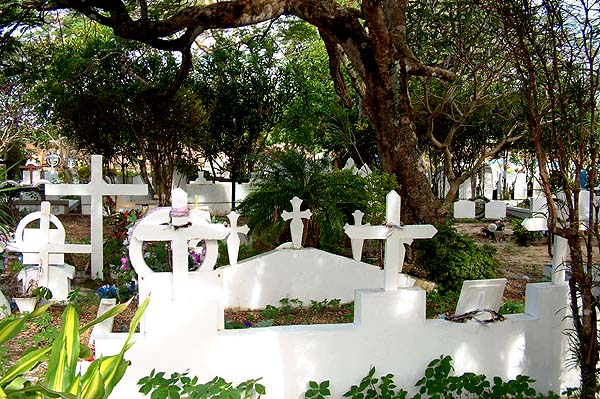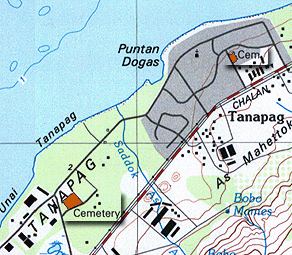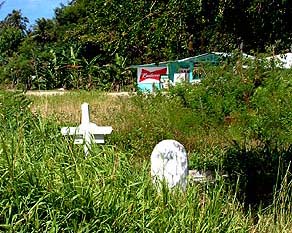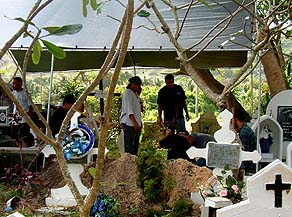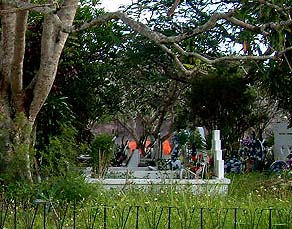 |
 |
 |
|||||
|
|
|
|
|
|
|
|
|
|
|
|||||||
|
|
|
|
Tanapag's traditional cemetery.
|
|
There are two cemeteries in Tanapag, the main one being in what is now called "Lower Base." Rosa Castro explains why there are two: "When we moved here from Chalan Kanoa after the War, in 1947, we put a second cemetery up here. That’s because this area from the beach up to the highway was closed off because inside it belonged to the Navy. So we could not bury our people there when they died."
|
||
| |
||
"So we just dug here and buried. In 1957, they let us bury our dead back there. But from 1947 when we moved to Tanapag until 1957, they could not let us because that belonged to the Navy. After the Navy moved out, we stopped burying here, and we continued again there. "Some people, they moved their family, the ones they buried here and brought them to the Lower Base cemetery because some of their family that died during Japanese time were buried there. Those who died after the War, they buried here, but when they re-opened Lower Base, they moved them back to the old cemetery."
|
|
|
"But some people are still here. My neighbors' grandfather and grandmother are in here. So the priest is really busy every November first and second, when we have ceremonies. "Sometimes we have a ceremony at nine o’clock in the morning here, after mass. After that ceremony here at nine o’clock he continues to the San Roque cemetery. And after lunch around 3 o’clock, he comes back to Tanapag, because we have only one priest for these three cemeteries."
|
|
|
|
“When I was small, and somebody died in the village, we took the body to the cemetery. And we couldn't shout or talk, because of deep respect. And when a lady has her time of the month, she could not go in, she had to go back home and not go in, out of respect for the people who already died—the ones who were first buried there, and the others thereafter. That is the custom: we cannot shout, we cannot go in, ladies when they feel that one, they cannot go to see who’s died to be buried there. That is the custom." "In these times, they don’t know how to be respectful. Some people go and they shout and make noise. But before, we didn't talk, we just went quietly, because we really respected the custom for the cemetery."
|
||
|
|
||
"Also if a woman is pregnant, she cannot go there. That’s our custom. That’s why when my daughters are pregnant, every time somebody in the village dies and we’re going to put them in the cemetery, they want to go, but I say, ‘You cannot. It’s no good to break the custom about the cemetery.’ I heard the same thing from my mom and from the old people. "Even pregnant ladies or anyone with something wrong, they just go. And we old ladies, we just say ‘Lucky if nothing goes wrong with her stomach, that lady,’ because when you go there, and you’re pregnant or something, you may get hurt, something may fall on your body. These days, I don’t know.”
|
|
|
“We have a little bit of ceremony at the cemetery,” Ben says, “the last rites of a person before he or she is lowered down in the grave. They’ll lay you primarily in an east-to-west direction, with your head next to the cross. Of course, you’re six feet down. I heard from other people that they basically put east-west orientation, because they say the head is pointing east with the cross because the departed ones will get up normally and go east where the sunrise comes up. I don’t know if that’s true.” Estella suggests it is not the direction itself, but an orientation towards the sea: “They say that you can tell if they are gone from the cemetery, because you can see their footprints on the grave. And they say that if the footprints face the ocean that means they are gone. And if the footprints face the land, that means they are still around.”
|
|
|
|
Mourners attend the last rites.
|
“After we bury whoever died in the family,” Rosa elaborates, “it’s a Carolinian custom that early in the morning the next day, at about five o’clock or four-thirty, we’ll be there in the cemetery. You have to light the candles. If you have some money, buy some pugua (betel nut), and take it over, offer whatever you find that morning. And the next morning like four o’clock or five o’clock you have to go there before dawn. And in the evening too, you have to go again and clean whatever leaves have fallen down, as though you are still thinking of this person, you have not forgotten yet. And you complete four mornings, four nights."
|
||
|
|
||
“When my mom died, we did the same thing,” Ben recalls. “I don’t know what happened to my sisters at 5:00 a.m. I went down there by myself and I was there all by myself and you know you can hear things when you’re by yourself. I heard music, I heard coughing, I heard many strange sounds. I think I was scaring myself more than I was actually hearing anything. It’s probably my vivid imagination. “Anyway, nobody showed up and I was scared to death all by myself at the cemetery. It’s not a picnic place. It’s a place of death, and you know, many dead people are there, and so I ran back to the house and all of them were still sleeping and I said ‘What happened to you guys? It’s 6:00!’ And they said ‘Oh!’ and they all got up and we all went down there.”
|
|
|
"But you better be careful on the third day after we bury," Rosa warns, "You may see something on the sand at the cemetery. Because when you bury someone, you have to get some sand to level the burial place, so on the third day after, you look first at what you can see on the sand. You may see that something like a crab has left a note you can see. That’s the last thing you can see from that person. A crab or animal or something may write it." “My son died in 1975, on September 27. I was in Pohnpei and I came. The next day was going to be the fourth morning after we buried, and I really saw many words he had written. A small snail came out from behind the cross at the head of the grave, and ran and ran and ran on the sand, and that writing was words. We saw the snail go back behind the cross, we all knew he just went to the back, but when the young boy went to try to catch it, nothing. We looked all around; nothing."
|
|
|
|
“There had been a little bit of rain that morning, and I cannot read well, but my brother-in-law’s son and my nephew, he read the words, and the last one, he said, ‘Good luck, Mom, and bye.’ And when he read that, I cried, because I know he’s really smart. But that snail made that, running like he was playing some run-and-go. And if you don’t believe me, you just ask my sister-in-law. She and her husband and my cousing and I saw it. So that is a custom of our people: in those first four days, we have to watch closely for what we are going to find. "I know some people, they don’t believe it, but we Carolinians, some Chamorro, too, they’ve already seen something when we tell them these stories.”
|
||
|
|
||
|
A special rite for the deceased, among Carolinians of the village, used to occur particularly on Managaha Island .
|
||
|
|
||
|
|
|
|
|
|

|
| Tanapag Home | Map Library | Site Map | Pacific Worlds Home |
|
|
|
|

|
|
|
|||
| Copyright 2003 Pacific Worlds & Associates • Usage Policy • Webmaster |
|||
